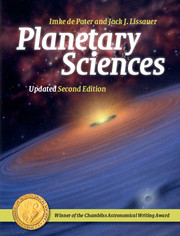Book contents
- Frontmatter
- Contents
- List of Tables
- Preface
- 1 Introduction
- 2 Dynamics
- 3 Solar Heating and Energy Transport
- 4 Planetary Atmospheres
- 5 Planetary Surfaces
- 6 Planetary Interiors
- 7 Magnetic Fields and Plasmas
- 8 Meteorites
- 9 Minor Planets
- 10 Comets
- 11 Planetary Rings
- 12 Extrasolar Planets
- 13 Planet Formation
- Appendix A List of Symbols Used
- Appendix B Acronyms Used
- Appendix C Units and Constants
- Appendix D Periodic Table of Elements
- Appendix E Observing Techniques
- Appendix F Interplanetary Spacecraft
- Appendix G Recent Developments in Planetary Sciences
- References
- Index
- Plate Section
Appendix E - Observing Techniques
Published online by Cambridge University Press: 05 January 2015
- Frontmatter
- Contents
- List of Tables
- Preface
- 1 Introduction
- 2 Dynamics
- 3 Solar Heating and Energy Transport
- 4 Planetary Atmospheres
- 5 Planetary Surfaces
- 6 Planetary Interiors
- 7 Magnetic Fields and Plasmas
- 8 Meteorites
- 9 Minor Planets
- 10 Comets
- 11 Planetary Rings
- 12 Extrasolar Planets
- 13 Planet Formation
- Appendix A List of Symbols Used
- Appendix B Acronyms Used
- Appendix C Units and Constants
- Appendix D Periodic Table of Elements
- Appendix E Observing Techniques
- Appendix F Interplanetary Spacecraft
- Appendix G Recent Developments in Planetary Sciences
- References
- Index
- Plate Section
Summary
In this appendix we briefly summarize aspects of observational planetary science. Techniques specific to extrasolar planets are discussed in §12.2. References to more extensive treatments are provided in the Further Reading section at the end.
E.1 Photometry
Photometry is a photon-counting technique, wherein the brightness of an object is measured. Time series of brightness measurements can be combined into a photometric lightcurve that shows, e.g., the variations in a body's brightness as the object rotates around its axis (Fig. 9.4).
Graphs of an asteroid's brightness in reflected sunlight as a function of phase angle, ø, usually show an abrupt increase in intensity at ø ≲ 2°, referred to as the opposition effect. The opposition effect for the Moon, shown in Figure E.1, is very large; the intensity increases by ∼20% from ø ∼ 2° down to ø = 0°. This is why a ‘full Moon’ can appear to be much brighter than a nearly full gibbous Moon. Part of the opposition effect can be attributed to the hiding of shadows when the Sun and observer are located in the same direction as seen from the object. Laboratory simulations of this phase angle effect, however, show that this is not the complete story. In any particulate material, multiple reflections diffusely scatter the incoming waves in all directions. At zero phase angle the waves interfere constructively, and the reflected intensity can be amplified considerably. This process is known as the coherent-backscatter effect. Both the shadow-hiding and coherent-backscatter contribute to the opposition effect. For the Moon, the coherent-backscatter effect results in the narrow peak near opposition at phase angles ø < 2°, whereas the broader component at ø < 20° can be explained by the shadow-hiding theory.
E.2 Spectroscopy
Spectroscopy pertains to the dispersion of light as a function of wavelength. Spectra can be used to derive, e.g., the composition of gaseous and solid objects, the temperature and pressure in an atmosphere (§4.3), and the radial velocity of an object via the Doppler shift (§12.2.2).
- Type
- Chapter
- Information
- Planetary Sciences , pp. 565 - 574Publisher: Cambridge University PressPrint publication year: 2015



